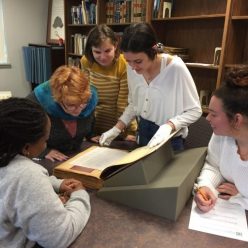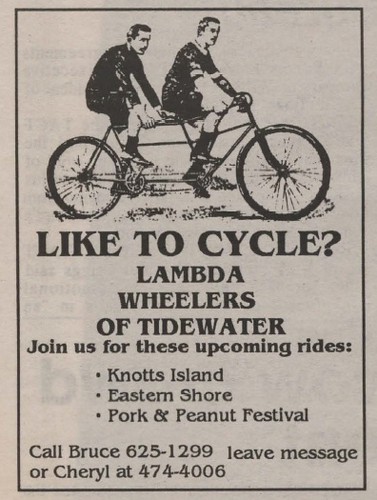By Mel Frizzell, Special Collections Assistant
October is National Gay and Lesbian History Month and October 11 is National Coming Out Day (NCOD).
National Coming Out Day has been an ODU tradition for LGBT folks on campus since 1989. In terms of ODU traditions, that’s a pretty long time. While founded as a Division of the College of William and Mary in Norfolk in 1930, ODU didn’t become a full-fledged university until 1969. It really hasn’t been until the last decade or two that ODU started thinking in terms of what traditions we have to offer, so an annual event celebrated at ODU since 1989… well in ODU terms that’s a pretty long time.
National Coming Out Day grew out of a February 1988 conference held in Virginia. Attending this event were approximately 200 LGBT leaders from across the United States. The day was envisioned as a way to carry forward the energy and enthusiasm from the October 11, 1987 Lesbian and Gay March on Washington. This march drew 600,000 people in a time when it was harder for LGBT folks to be open about their sexuality.
The purpose of National Coming Out Day is to encourage LGBT folks to “take the next step” in their coming out process – to push their boundaries, and to be truthful and open – but to do so in a way that is safe for them. This next step can be something private such as telling a family member or friend, or something public like being visible as an LGBT person in one’s community. National Coming Out Day recognized that coming out is often a lifelong process for LGBT individuals.
The purpose of the event is also to foster LGBT visibility. Unlike Gay Pride Day, which is all about celebrating the LGBT community, National Coming Out Day has been about LGBT folks letting the community at large know they exist and who they are. Unlike many marginalized communities, it isn’t always obvious who is LGBT. Many people don’t know that they know someone who is LGBT, and many LGBT folks remain in the closet for fear of harassment, job discrimination, or ridicule from friends and family. This was even more the case in the late 1980s when National Coming Out Day was founded than it is today. The cost of being invisible is that it fosters misunderstanding, stereotypes, and bigotry. Those who know someone who is LGBT are also more likely to support LGBT rights issues.
The first ever National Coming Out Day was held on October 11, 1988. It was organized by Jean O’Leary of the National Gay Rights Advocates and by Robert Eichberg founder of a personal growth workshop called “Experience Weekend.” The first National Coming Out Day was covered in both mainstream and LGBT publications. National publications providing coverage included USA Today, CNN, and NPR. Oprah Winfrey dedicated segments of her show that day to coming out.
After 1988, National Coming Out Day became its own organization to promote the annual event, to keep track of these events across the country, and to provide coming out resources. In 1990, the NCOD organization merged with the Human Rights Campaign to become the National Coming Out Day Project.
The ODU Gay and Lesbian Student Union (GLSU) was on board for the second ever National Coming Out Day on October 11, 1989. The GLSU officially started meeting as a student organization on campus earlier that year in the Spring semester. This first National Coming Out Day Social at ODU was held in the Suffolk Room in Webb Center from 3:30-5:30pm. The event included refreshments, discussion, and coming out resources. During the first decade and possibly much longer, this annual social at ODU was held in Webb Center. In 1990, the GLSU extended an invitation to folks from other local colleges and universities, as well as a local LGBT youth group, to attend. Music was also added to the line-up. In 1991, the event included the film “On Being Gay.” A National Coming Out Day exhibit was displayed in front of the ODU Bookstore that year. At the time, the bookstore was located in Webb Center. The display included LGBT books and buttons, as well as an official National Coming Out Day poster and t-shirt. In 1992, National Coming Out Day included a showing of the film “Since Stonewall.” In 1999, the film “Working with Gay, Lesbian, and Bisexual Students” was shown and a “Reflections Gallery” was created in Webb Center. The gallery was “A chance to view a collection of written thoughts, feelings, and experiences from the Old Dominion Community about gays, lesbians, and bisexuals. “
Today as LGBT people are more accepted by society, National Coming Out Day has come to be a day of celebration for the LGBT community. While largely a U.S. holiday, it is also celebrated internationally in Ireland, Switzerland, the Netherlands, and the United Kingdom.
National Coming Out Day has become one of many events held at ODU and across the U.S. in conjunction with LGBT History Month. LGBT History Month was founded in 1994 by a Missouri high school history teacher named Rodney Wilson. The month is celebrated in October to coincide with National Coming Out Day. LGBT History Month celebrates the contributions of LGBT individuals, organizations, and community to history and society, as well as the LGBT struggle for civil rights.
“Most people think they don’t know anyone gay or lesbian, and in fact, everybody does. It is imperative that we come out and let people know who we are and disabuse them of their fears and stereotypes.”
– Robert Eichberg, 1993
References:
“ODU gay group to hold social”, Our Own Community Press, October 1989, p. 7.
“Members of Old Dominion University’s Gay and Lesbian Student Union (GLSU) display their banner and a National Coming Out Day Poster (photo with caption)”, Our Own Community Press, November 1989. p. 17.
“The ODU GLSU Invites You! National Coming Out Day Social (advertisement), Our Own Community Press, October 1990, p. 6.
“October 11 is third annual National Coming Out Day”, Our Own Community Press, October 1990, p. 22.
“October 11 – Norfolk: Coming Out Day Social, Old Dominion University Gay and Lesbian Student Union (calendar listing)”, Our Own Community Press, October 1991, p. 21.
“October 8 – Norfolk: National Coming Out Day Social, ODU GLSU (calendar listing)”, Our Own Community Press, October 1992, p. 15.
“National Coming Out Day, Oct. 11”, Our Own Community Press, October 1993, p. 2.
National Coming Out Day Social (flyer), Box 2, Folder 10, Old Dominion University Gay and Lesbian Student Union (GLSU) Records, Special Collections and University Archives, Patricia W. and J. Douglas Perry Library, Old Dominion University Libraries, Norfolk, VA 23529.







